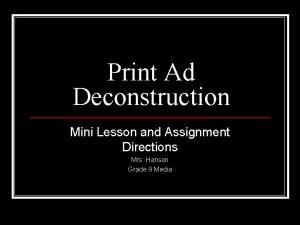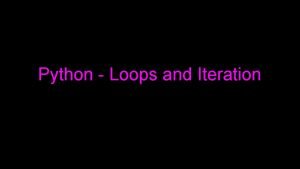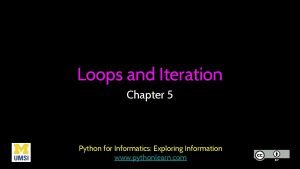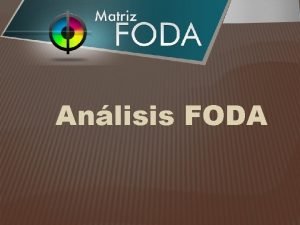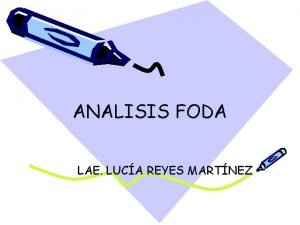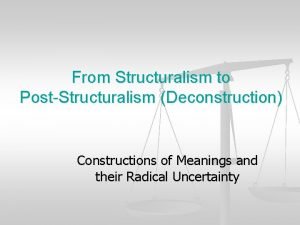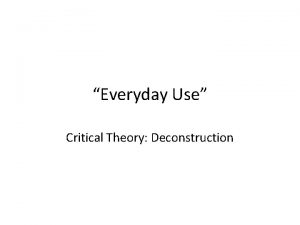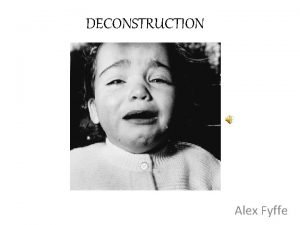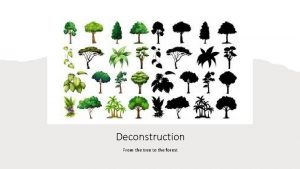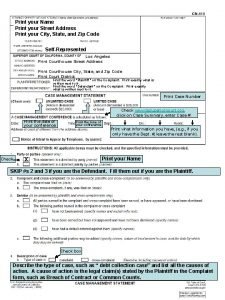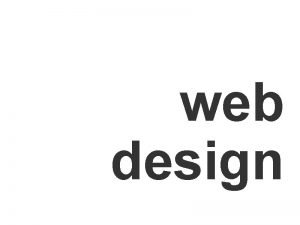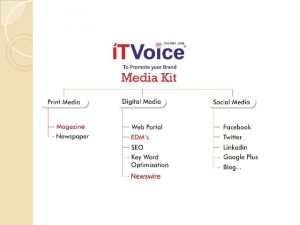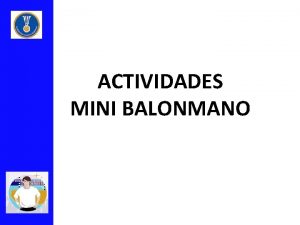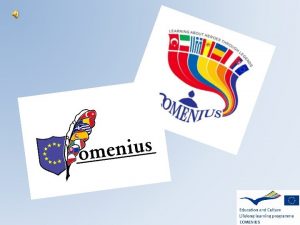Print Ad Deconstruction Mini Lesson and Assignment Directions











- Slides: 11

Print Ad Deconstruction Mini Lesson and Assignment Directions

What is DECONSTRUCTION? n Deconstruction is a method used to analyze media. n Deconstruction is when we take a media example apart to look at the pieces used to create it and the effect they have on the final product. n Deconstruction leads to identifying and understanding messages conveyed beyond the selling of the product or service.

What do you have to do? 1. Get the needed materials: a print ad that you find interesting, poster board, glue, scissors, markers etc. 2. Study the ad. Use the questions on the assignment handout to guide your study and create rough copy notes. 3. Revise and edit your notes--add details and support for your ideas from the ad. 4. Prepare good copy and assemble poster. 5. Prepare to present your findings.

a) b) c) d) e) a) b) c) d) CONTENT Who/what is emphasized Facial expression/body language Use of computer retouching The action featured Objects/setting/colors COMPOSITION Use of blank space Juxtaposition of items Details in the foreground or background What is excluded or cropped PRINT AD DECONSTRUCTION LANGUAGE/RHETORIC a) b) c) d) Word choice Use of adjectives Punctuation typography a) b) c) APPEALS TO NEEDS OR DESIRES? What need? Does it play to fears? How? What solution does it offer? Is the solution realistic? CAMERA DISTANCE & ANGLE a) b) c) d) e) High angles (looking down) suggesting vulnerability Low angles (looking up) suggesting power Close ups – suggesting intimacy Long shots – suggesting distance Eye-level shots suggesting equality a) b) c) d) e) f) g) LIGHTING Brightness/darkness Top lighting Side lighting Bottom lighting Back lighting Artificial lighting Natural lighting. a) b) c) TARGET AUDIENCE Describe target audience by age, gender, income level, or other identifying features. Describe the actors/models & the scenario in which they appear. CULTURAL IMPACT Are the beliefs of one particular group represented? Who is in a position of power and who is not? Are any stereotypes used? Describe them. What views of happiness & success are implied?

CONTENT: The ad emphasizes a young, blonde, slender woman in the process of throwing a tricycle at a giant ice cream bar. The ice cream bar is as large as she. The woman is standing on one leg. It would be easy to knock her off balance (symbolism). One arm holds the tricycle; the other arm is directed at stopping the ice cream bar. The ice cream bar is “hiding” behind a lamp post. In the background is a plump woman with brown hair, a sun hat, and a blue baby carriage. They appear to be in a park as the surroundings are green grass and trees, and a brick walkway. In the lower right corner is an image of the product and the slogan. A tag line is in white at the bottom of the page.

COMPOSITION: The walkway leads the eye to the woman. Her hand gaze direct us to her attacker (the ice cream) which is on the far right of the page, and then to the solution (the product featured in right lower corner). The woman and the ice cream treat are the focus of the ad. The use of yellow as dominant color for both the woman and the ice cream bar- along with their placement opposite one another - emphasizes that the two are at odds. The green foreground and background add emphasis to the featured characters. Seated in the background (unlike our active, feisty food warrior) is a plump woman seated passively on a bench. By being in the background, she is marginalized. Closest in the foreground is an image of the product, a slogan, and a tag line.

CAMERA DISTANCE & ANGLE The camera angle appears to be taken at eye-level suggesting that we are on “equal ground” with the woman. The image appears to be taken at mid-range implying neither intimacy nor distance from the subject of the ad. LIGHTING The image uses natural lighting. The woman and the ice cream attacker are in full sun, while the woman on the bench is near the shade (i. e. “in the dark” both literally & figuratively).

LANGUAGE/RHETORIC “Survive a Snack Attack” “Fight back with Trident Splash, the sugar free gum with a juicy liquid center, and get the sweet without the snack. ” The words and phrases --“Survive” and “Fight Back” – imply that feeding one’s hunger is dangerous. The phrase “Snack Attack” is written in larger font than other text on the page. The size of the font, combined with the rhyming of the two words, add impact to the phrase. The unstated message of this ad is that women’s bodies must be controlled. If we want to be beautiful, we must fight against our body’s natural desires. The woman in this image is thin, feminine (dainty shoes/sundress) and strong (she is holding a trike over head). If we want to be like this, we must fight the urge to eat.

Appeals to Needs & Desires According to Maslow’s theory, the advertiser is connecting Trident to esteem needs. The ad suggests that the audience will achieve success, confidence and power if they resist the temptation to eat and chew this gum instead. The ad appeals to our fears of being “on the side lines” if we succumb to our hunger and become weak, passive, overweight, on-lookers. It juxtaposes the ideal self with the feared self. This is an unrealistic message as chewing gum does not lead to success, confidence, and power.

TARGET AUDIENCE The intended audience is young to middle age women of middle-income. CULTURAL IMPLICATIONS The stereotype of beauty as a female who is slender, feminine, blonde, white, and athletic is a construction of those who would like women to be this way. In this ad, the blonde has more power than the plump brunette. This reinforces cultural stereotypes of beauty (blonde, slender, white, active) and presents overweight older women as not worthy of attention. Although the woman in the foreground does not seem to be happy, it is assumed she would NOT be happy if she did not “survive a snack attack” which is why she is fighting off her sugar-laden “villain”

a) b) c) d) e) a) b) c) d) CONTENT (10 pts) Who/what is emphasized Facial expression/body language Use of computer retouching The action featured Objects/setting/colors PRINT AD DECONSTRUCTION Student’s Name HAC – Period Due Date: 1/17/18 COMPOSITION (10 pts. ) Use of blank space Juxtaposition of items Details in the foreground or background What is excluded or cropped LANGUAGE/RHETORIC (10 pts) a) b) c) d) a) b) c) CAMERA DISTANCE & ANGLE (5 pts) a) b) c) d) e) High angles (looking down) suggesting vulnerability Low angles (looking up) suggesting power Close ups – suggesting intimacy Long shots – suggesting distance Eye-level shots suggesting equality a) b) c) d) e) f) g) LIGHTING (5 pts) Brightness/darkness Top lighting Side lighting Bottom lighting Back lighting Artificial lighting Natural lighting. a) b) c) Print ad from magazine: (10 pts. ) Word choice Use of adjectives Punctuation typography APPEALS TO NEEDS OR DESIRES? (10 pts. ) What need? Does it play to fears? How? What solution does it offer? Is the solution realistic? TARGET AUDIENCE (10 pts. ) Describe target audience by age, gender, income level, or other identifying features. Describe the actors/models & the scenario in which they appear. CULTURAL IMPACT (30 pts) Are the beliefs of one particular group represented? Who is in a position of power and who is not? Are any stereotypes used? Describe them. What views of happiness & success are implied?
